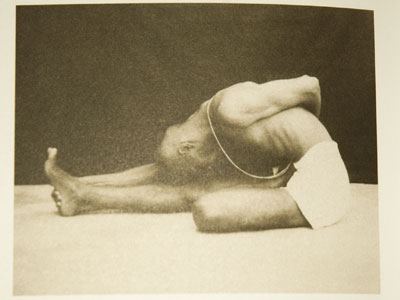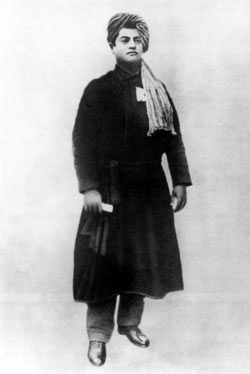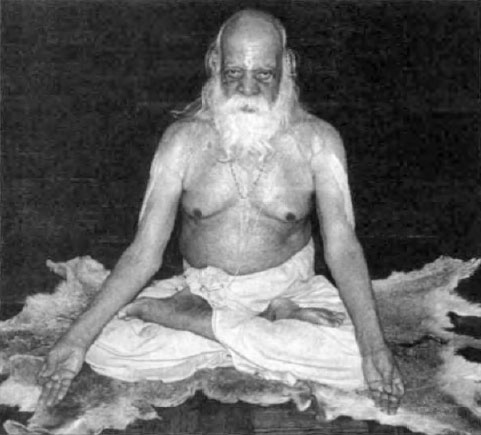TO JALANDHARA BANDA, OR NOT TO JALANDHARA BANDHA? 
In April, senior ashtanga teacher
Lino Miele told us that in the ashtanga vinyasa yoga system,
Jalandhara Bandha (the chin-lock) is not used during the
asana (posture) portion of practice. He said that it is only used for
pranayama (breathing). “There are a few things that Guruji [Sri K. Pattabhi Jois] was very particular to teach,” he said. “This is how I know if it came from him or somewhere else.
“Once the guru dies, everyone goes like this,” he said, spreading out his arms. “I don't want to go like this.”
In August,
David Williams (the first American to study with Pattabhi Jois) took me aside before his workshop, and told me that he liked my article about Lino, but that it was wrong when it came to
Jalandhara Bandha. He said that the chin-lock is done in every pose. He had a text by Sri Tirumalai Krishnamacharya (the guru of Pattabhi Jois) to back him up. It said, "When I explain the rules of
yogasana [yoga postures], if the position of the head has not been specified, then keep the head in
jalandhara bandha."
I said to DW that the correct response would be to write a letter to the editor. DW said he did not want to pursue it. I said that ashtanga is interesting that way; in April, Lino Miele said that
Mula Bandha (the root lock) means to pull up the anus. From my
Yoga Chicago article:
When he was writing the books with Guruji (they also completed a book on advanced A and B series, which has not yet been published), Lino said he brought in some other yoga books, and told Guruji he was confused about mula bandha. “Gurji threw away the books. He said, ‘I am the book. You and I are writing the book, and you go to other books?'
“OK, Guruji--but where is mula bandha?”
“‘The anus.'”I told DW that a month later,
Tim Miller (the first American certified to teach the ashtanga system) came to town and told us that
Mula Bandha does
not mean to pull up the anus. From my article in the September/October
Yoga Chicago, which is not yet online:
Tim began “The Mysterious and Elusive Bandhas” by explaining, “mula bandha [root lock] doesn’t mean to contract your anus.” Instead, the action involves lifting the tailbone towards the pubic bone. I told DW that I found the differences rather amusing.
As for the chin-lock, I recalled that the old pictures of Pattabhi Jois show him doing something like it in the seated forward bends (one year,
David Roche, who is a certified teacher *and* a big-time mixer, came to town and had us do all the poses old-school like that. It felt good on the back, and it was easier to catch the bottom two locks. But it did not feel
right).

I figured that at some point, it shifted to from chin-to-chest to chin-to-shin in the seated forward bends, with eyes towards the feet.
What I didn't say was that at some point these debates are a bit like the war over which side to open the hard-boiled egg on in the
Lilliput section of
Gulliver's Travels.
After my discussion with David W, I attended his led primary series workshop at his invitation. He had the students do
Jalandhara Bandha in each and every pose.
The following week, the regular Mysore students were still practicing that way, and we had a discussion. I said that the reason for many differences is that Guruji's teachings evolved over the years. (What I did not say is that many differences are due to younger / newer / careless instructors teaching incorrectly, which is a whole 'nother post). I said that I tend to go with my own 12 months of experience with Guruji and what Lino says, since he spent so much time with Guruji trying to get everything straight. After all, how can you look at your foot (the correct
dristi, or gaze, in most seated forward bends) if your chin is at your chest? I suggested they find some sort of middle way: neck neutral, eyes towards feet, forehead relaxed. But when I practice, I do chin-to-shin.
On Tuesday, I found
Jason Stein's notes from a July 28, 2004 conference with Guruji and Sharath in Mysore:
"Jalandhara bandha is only to be engaged during pranayama, not during asana practice." Straight from the Guru. To Jason. To you.
Although Jason adds a caveat:
"Take as gospel at your own risk."




















